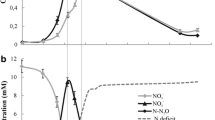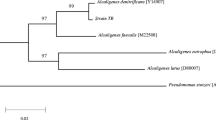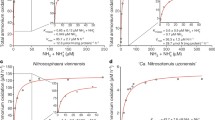Abstract
AnAlcaligenes sp. isolated from soil was characterized as to its ability to oxidize and grow on pyruvic-oxime. Abundant nitrification of pyruvic-oxime was demonstrated with maximal nitrite and nitrate production of 1867 mg NO2 −-N per liter and 42 mg NO3 −-N per liter. TheAlcaligenes sp. oxidized hydroxylamine and this metabolism was stimulated when either acetate or pyruvate was present. This organism was also capable of limited pyruvic-oxime oxidation when cultured in an acidic medium. The metabolism of pyruvic-oxime and nitrification by theAlcaligenes sp. in the environment are discussed.
Similar content being viewed by others
Literature Cited
Alexander, M., Marshall, K. C., Hirsch, P. 1960. Autotrophy and heterotrophy in nitrification, pp. 586–591. Transactions of the International Congress of Soil Science, 7th. Madison, Wisc.
Amarger, N., Alexander, M. 1968. Nitrite formation from hydroxylamine and oximes byPseudomonas aeruginosa. Journal of Bacteriology95:1651–1657.
Becker, G. E., Schmidt, E. L. 1964. B-nitropropionic acid and nitrite in relation to nitrate formation byAspergillus flavus. Archiv für Mikrobiologie49:167–175.
Berger, P. S., Rho, J., Gunner, H. B. 1979. Bacterial supression ofChlorella by hydroxylamine production. Water Research13:267–273.
Castignetti, D., Gunner, H. B. 1980. Sequential nitrification by anAlcaligenes sp. andNitrobacter agilis. Canadian Journal of Microbiology26:1114–1119.
Doxtader, K. G., Alexander, M. 1966. Nitrification of growing and replacement cultures ofAspergillus. Canadian Journal of Microbiology12:807–815.
Doxtader, K. G., Alexander, M. 1966. Nitrification by heterotrophic soil microorganisms. Soil Science Society of America Proceedings30:351–355.
Eylar, O. R., Schmidt, J., Schmidt, E. L. 1959. A survey of heterotrophic microorganisms from soil for ability to form nitrite and nitrate. Journal of General Microbiology20:473–481.
Focht, D. D., Verstraete, W. 1977. Biochemical ecology of nitrification and denitrification. Advances in Microbial Ecology1:135–214.
Gomori, G. 1955. Preparation of buffers for use in enzyme studies, pp. 138–146. In: Colowick, S. P., Kaplan, N. O. (eds.), Methods in enzymology, vol. 1. New York: Academic Press.
Grossowicz, N., Lichtenstein, Y. 1961. Enzymic binding of hydroxylamine by fumaric acid. Nature191:412–413.
Gunner, H. B. 1963. Nitrification byArthrobacter globiformis. Nature197:1127–1128.
Hilali, A., Molina, J. A. 1979. Nitrate and nitrite reduction by microorganisms embedded in a filter paper incubated aerobically. Applied and Environmental Microbiology38:1140–1143.
Jensen, H. L. 1951. Nitrification of oxime compounds by heterotrophic bacteria. Journal of General Microbiology5:360–368.
Lees, H., Simpson, J. R., Jensen, H. L., Sorensen, H. 1954. Formation of nitrite from oximes and hydroxylamine by microorganisms. Nature173:358.
Obaton, M., Amarger, N., Alexander, M. 1968. Heterotrophic nitrification byPseudomonas aeruginosa. Archiv für Mikrobiologie63:122–132.
Quastel, J. H., Scholefield, P. G. 1949. Influence of organic nitrogen compounds on nitrification in soil. Nature164:1068–1072.
Quastel, J. H., Scholefield, P. G., Stevenson, J. W. 1950. Oxidation of pyruvic-oxime by soil organisms. Nature166:940–942.
Remacle, J. 1977. The role of heterotrophic nitrification in acid forest soils—preliminary results. Ecology Bulletin (Stockholm)25:560–561.
Rice, E. L., Pancholy, S. K. 1972. Inhibition of nitrification by climax ecosystems. American Journal of Botany59:1033–1040.
Rice, E. L., Pancholy, S. K. 1973. Inhibition of nitrification by climax ecosystems. II. Additional evidence and possible role of tannins. American Journal of Botany60:691–702.
Rice, E. L., Pancholy, S. K. 1974. Inhibition of nitrification by climax ecosystems. III. Inhibitors other than tannins. American Journal of Botany61:1095–1103.
Romanovskaya, V. A., Shurova, Z. P., Yurchenoko, V. V., Tkachuk, L. V., Malashenko, Y. R. 1977. Investigation of the ability of obligate methylotrophs for nitrification. Translated from Mikrobiologiya46:66–70.
Saris, N. E., Virtanen, A. I. 1957. On hydroxylamine compounds inAzotobacter cultures. I. Formation of hydroxylamine compounds. Acta Chemica ScandinavicaII:438–1440.
Schmidt, E. L., Molina, J. A., Chiang, C. 1973. Isolation of chemoautotrophic nitrifiers from Moroccan soils. Bulletin of Ecological Research Communications (Stockholm)17:166–167.
Verstraete, W. 1975. Heterotrophic nitrification in soils and aqueous media. Translated from Izvestiya Akademii Nauk S.S.S.R. (Ser. Biolog.)4:541–558.
Verstraete, W., Alexander, M. 1972. Heterotrophic nitrification byArthrobacter sp. Journal of Bacteriology110:955–961.
Verstraete, W., Alexander, M. 1972. Heterotrophic nitrification in samples from natural environments. Naturwissenschaften59:79–80.
Verstraete, W., Alexander, M. 1972. Mechanisms of nitrification byArthrobacter sp. Journal of Bacteriology.110:962–967.
Verstraete, W., Alexander, M. 1973. Heterotrophic nitrification in samples of natural ecosystems. Environment Science and Technology.7:39–42.
Virtanen, A. L., Hakala, M., Jarvinen, H. 1949. Formation of oxime-nitrogen in anaerobic nitrogen fixation. Acta Chemica Fenn. B22:23–29.
Virtanen, A. L., Laine, T. 1939. Investigations on the root nodule bacteria of leguminous plants. Biochemical Journal33:412–416.
Wiley, P. F., Herr, R. R., Mackeller, F. A., Argoudelis, A. D. 1965. Three chemically related metabolites ofStreptomyces. II. Structural studies. Journal of Organic Chemistry30:2330–2334.
Yamafuji, K., Akita, T. 1952. On transoximation. Enzymology15:313–317.
Yamafuji, K., Konda, H., Omura, H. 1950. Distribution of oxime in plant and animal tissues. Enzymology14:153–156.




